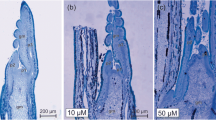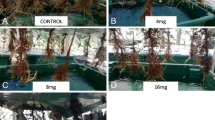Abstract
Cadmium (Cd) is one of the most common heavy metal contaminants in the environment. Cd pollution adversely affects the plant growth and development. Datura stramonium L. plants, as an experimental model, were investigated for the soil Cd pollution effects on the perianth and anther formation development. The soil was contaminated by cadmium chloride in different rates (0 and 225 mg kg−1) and placed in the experimental pots (4 kg soil/pot). The tiny blossoms and buds, in different developmental stages, were removed, fixed in FAA70, stored in 70% ethanol, embedded in paraffin and sliced at 7 µm with a microtome. Different staining methods including haematoxylin–eosine and Alexander’s stain were used. The developmental stages of reproductive organs were examined by light microscopy and scanning electron microscopy. The results showed that Cd can cause some abnormalities during the developmental process of pollens and ovule. Under Cd treatment, some changes were observed in a tapetum layer. In Cd-treated group, fragility, vacuolization and size of pollen grains were increased in comparison with control. A decrease in the bioavailability of pollen and degeneration of embryo sac cells were the results of Cd that Cd is capable of inducing chromosomal aberrations. Abnormalities in male organs were more than in female ones. This study showed the range of disturbances in floral structures and provides a good set of features to determine Cd-contaminated stress tolerance.





Similar content being viewed by others
References
Alves P (1988) Efeiots nutricionais da chuva acida simulada e do Latossolo Vermelho-Amarelo de Cubatao-SP, em soja (Glycine max L.). M.Sc., Universidade Federal de Vicosa, Minas Gerais, Brasil
Chehregani A, Majde A, Moin M, Gholami M, Shariatzadeh MA, Nassiri H (2004) Increasing allergy potency of Zinnia pollen grains in polluted areas. Ecotoxicol Environ Saf 58:267–272
Chehregani A, Lari Yazdi H, Hoseini S, Majd A (2007) Toxic effects of diesel exhaust particles on ovules and embryonic sac development in Phaseolus vulgaris L. Middle East Rus J Plant Sci Biotechnol 1:54–56
Chehregani A, Malayeri B, Yousefi N (2009) Developmental stages of ovule and megagametophyte in Chenopodium botrys L. (Chenopodiaceae). Turk J Bot 33:75–81
Chehregani A, Ramezani H (2016) The study of anther and pollen developmental stages in Petunia hybrida Juss. Iran J Plant Biol 29:95–105
Chehregani Rad A, Ramazani H, Mohsenzadeh F, Baghaiefar Z, Babolhavaeji H (2014) The effect of cadmium on development of anther and pollen grains and protein pattern in Petunia hybrida Juss. J Cell Tissue 5:71–86
Das P, Samantaray S, Rout G (1997) Studies on cadmium toxicity in plants: a review. Environ Pollut 98:29–36
Emberlin J (1998) The effects of air pollution on allergenic pollen. Eur Respir Rev 8:164–167
Gratão PL, Monteiro CC, Tezotto T, Carvalho RF, Alves LR, Peters LP, Azevedo RA (2015) Cadmium stress antioxidant responses and root-to-shoot communication in grafted tomato plants. Biometals 28:803–816
Kabata-Pendias A (2010) Trace elements in soils and plants, 3rd edn. CRC Press, New York
Koduru P, Rao MK (1981) Cytogenetics of synaptic mutants in higher plants. Theor Appl Genet 59:197–214
Kumar G (2003) Comparative analysis of meiotic abnormalities induced by gamma rays and EMS in barley. J Ind Bot Soc 82:19–22
Kumar G, Rai P (2007) Comparative genotoxic potential of mercury and cadmium in soybean. Turk J Biol 31:13–18
Malayeri B, Chehregani A, Mohsenzadeh F, Golmohammadi R (2005) Effect of heavy metals on the development stages of ovule and embryonic sac in Euphorbia cheiradenia. Pak J Biol Sci 8:622–625
Metwally A, Finkemeier I, Georgi M, Dietz KJ (2003) Salicylic acid alleviates the cadmium toxicity in barley seedlings. Plant Physiol 132:272–281
Mittal N, Srivastava AK (2014) Cadmium- and Chromium-induced aberrations in the reproductive biology of Hordeum vulgare. Cytologia 79:207–214
Mosa KA, Saadoun I, Kumar K, Helmy M, Dhankher OP (2016) Potential biotechnological strategies for the cleanup of heavy metals and metalloids. Front Plant Sci 7:303–312
Mulcahy DL (1981) Pollen tetrads in the detection of environmental mutagenesis. Environ Health Perspect 37:91–94
Nakashima H, Horner HT, Palmer R (1984) Histological features of anthers from normal and ms3 mutant soybean 1. Crop Sci 24:735–739
Peterson R, Slovin JP, Chen C (2010) A simplified method for differential staining of aborted and non-aborted pollen grains. Int J Plant Biol 1:66–69
Rezanejad F (2013) The response of anther and pollen development, pollen cellular material release and pollen proteins to air pollution in Petunia hybrida Juss. (Solanaceae). Iran J Sci Technol 37:63–68
Shah FUR, Ahmad N, Masood KR, Peralta-Videa JR (2010) Heavy metal toxicity in plants. In: Ashraf M, Ozturk M, Ahmad MSA (eds) Plant adaptation and phytoremediation. Springer, Berlin, pp 71–97
Shirkhani Z, Chehregani Rad A, Gholami M, Mohsenzadeh F (2018) Phytoremediation of Cd-contaminated soils by Datura stramonium L. Toxicol Environ Health Sci 10:168–178
Tran TA, Popova LP (2013) Functions and toxicity of cadmium in plants: recent advances and future prospects. Turk J Bot 37:1–13
Yousefi N, Chehregani A, Malayeri B, Lorestani B, Cheraghi M (2011) Effect of the heavy metals on the developmental stages of ovule and seed proteins in Chenopodium botrys L. (Chenopodiaceae). Biol Trace Elem Res 144:1142–1149
Author information
Authors and Affiliations
Contributions
ACR and MGH, as professors, designed the study. ZShH, as PhD student, performed the field work and laboratory experiments. All authors contributed to the writing of the manuscript.
Corresponding author
Additional information
Publisher's Note
Springer Nature remains neutral with regard to jurisdictional claims in published maps and institutional affiliations.
Rights and permissions
About this article
Cite this article
Shirkhani, Z., Chehregani Rad, A. & Gholami, M. Effects of cadmium on perianth and anther formation in Datura stramonium L.. Braz. J. Bot 43, 239–246 (2020). https://doi.org/10.1007/s40415-020-00595-7
Received:
Revised:
Accepted:
Published:
Issue Date:
DOI: https://doi.org/10.1007/s40415-020-00595-7




